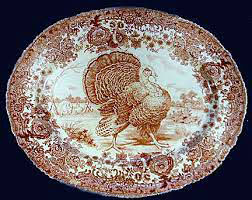
ANSWER: Many families still use a large turkey platter. Though large but not very sophisticated, it often features a 22-inch pattern manufactured by Homer Laughlin. It’s got high sides and can hold a very large turkey, and by now it’s even got a few rim chips, but it’s part of the family.

Thus, the same image often appeared on many of their turkey platters—a bird with its tail feathers fanned out fully, set against a rural farmyard background. The platters featured wide rims in Harlequin yellow and turquoise blue.
In the mid-1950s, a similar design appeared on Thanksgiving platters made by Taylor, Smith & Taylor, which the company sold to retailers to use as an advertising premium.
In its "Historical America" series, Laughlin also produced an elaborate scene from 1621 called "The First Thanksgiving," transfer printed in rose pink and sold exclusively through F.W. Woolworth. The company also produced a similar "Bountiful Harvest" platter showing Pilgrims and Indians gathering and sharing food.
A somewhat scrawnier bird appears on platters and plates made by Southern Potteries Inc., a Tennessee firm formerly known as Clinchfield Potteries. It began in 1917 by producing commercial, semi-vitreous china tableware decorated with stock transfers.
Its better-known trademark, Blue Ridge, debuted in 1932. By the late 1930s, it had switched from transfers to underglazed hand-painted decoration. Within 15 years, it had become the largest American producer of hand-painted china, with an annual production of 24 million pieces. Some of the firm’s top artists signed a limited number of special designs, and these are among the most coveted pieces for collectors.
For example, there’s a wild turkey platter painted and signed by artist Mildred L. Broyles, depicting a standing, long-necked bird eyeing a bug, valued at over $2,000. Another, signed by Louise Gwinn called “Turkey Gobbler,” shows a bird in a woods and sells for over $1,750.

To read more articles on antiques, please visit the Antiques Articles section of my Web site. And to stay up to the minute on antiques and collectibles, please join the over 30,000 readers by following my free online magazine, #TheAntiquesAlmanac. Learn more about "Lady Luck" in the 2024 Fall Edition, online now. And to read daily posts about unique objects from the past and their histories, like the #Antiques and More Collection on Facebook.






No comments:
Post a Comment